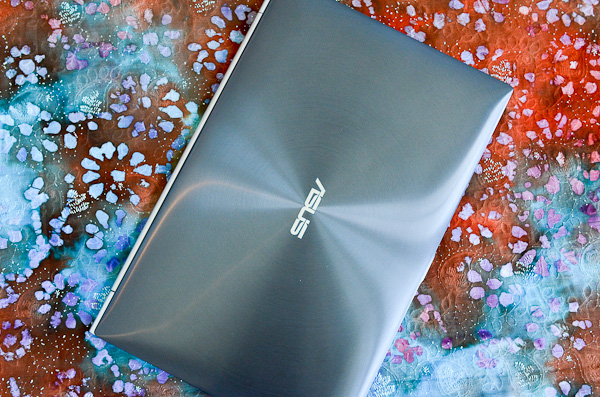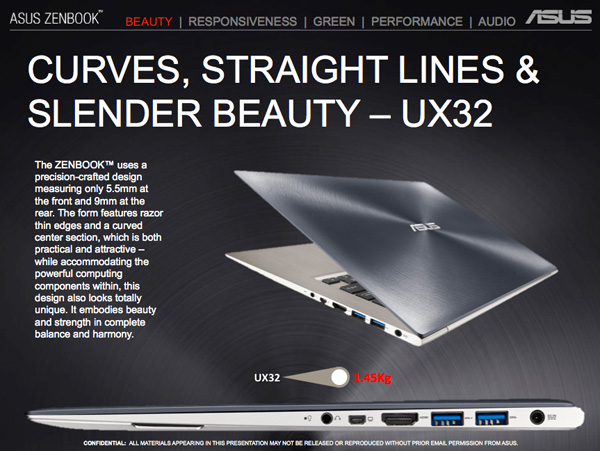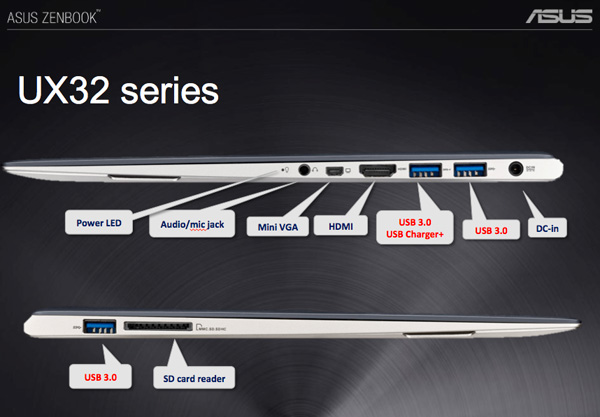ASUS Zenbook Prime (UX21A) Review: The First of the 2nd Gen Ultrabooks
by Anand Lal Shimpi on May 22, 2012 2:46 PM EST- Posted in
- Laptops
- CPUs
- Asus
- Ivy Bridge
- Zenbook
- Zenbook Prime
- Ultrabook
- Notebooks
The first round of Ultrabooks were mostly underwhelming. It shouldn't be a surprise, but many of the efforts were just half hearted at best. Of the companies who shipped the first Ultrabooks however, it was ASUS who came the closest to perfection with the Zenbook.
ASUS' Zenbook embodied the form factor, portability and overall concept of an Ultrabook. Where it failed to deliver was with its keyboard, display and, at least initially, with its trackpad. The first Zenbook was an amazing effort given the short period of time that it was conceived and developed in, but it was too rough around the edges.
Despite only being introduced 7 months ago, the Zenbook is old news. This is the Zenbook Prime:
The Zenbook Prime is ASUS' second generation Ultrabook, built around Ivy Bridge silicon. Unlike most silicon updates to notebooks however, the Zenbook Prime takes an almost Apple-like approach to renovating the tangibles rather than just relying on a faster chip to do the heavy lifting.
I don't know that I've ever seen a faster turn around on implementing reviewer and user feedback into a product. The Zenbook Prime fixes nearly every issue I had with the original Zenbook. From keyboard to display, it's all significantly better with the Zenbook Prime.
The circumstances around today's launch are a bit peculiar. Intel has an embargo in place on the as of yet unreleased Ivy Bridge CPUs, this applies to both notebooks and desktops. One such line of CPUs, the dual-core ultra-low-voltage Ivy Bridge parts that will find their way into many Ultrabooks, is covered by the aforementioned embargo. That embargo lifts at some point in the not too distant future, but ASUS wanted to have its review-ready hardware out the door and getting coverage before then. Why the urgency? It could have something to do with Apple's expected launch of updated MacBook Air and MacBook Pro systems. Rather than for Apple to get all the glory for being first, ASUS set some guidelines: we're allowed to talk about everything to do with the new Zenbook Primes, we just can't get into specifics on the CPU just yet. That's right, you won't read any model numbers, clock speeds or cache sizes here. Given what's already public about the ULV Ivy Bridge lineup I suspect this information isn't too hard to figure out if you're really motivated.

Zenbook Prime (left) vs. Zenbook (right)
The rest of the Zenbook Prime has nothing to do with Ivy Bridge. The form factor of the Zenbook Prime remains unchanged from its predecessor. Just like before we'll see two distinct models, an 11-inch (UX21) and 13-inch (UX31) in for review. With the lid closed, these two look identical to their Prime-less (composite numbered?) counterparts. ASUS sent the 11-inch Zenbook Prime in for review:
| ASUS Zenbook Prime Specs | |||||||||
| UX21A-DB5x | UX21A-DB7x | UX31A-DB51 | UX31A-DB52 | UX31A-DB71 | UX31A-DB72 | ||||
| CPU | ULV IVB | ULV IVB | ULV IVB | ULV IVB | ULV IVB | ULV IVB | |||
| GPU | HD 4000 | ||||||||
| Display | 11.6-inch 1920 x 1080 IPS | 13.3-inch 1920 x 1080 IPS | |||||||
| Memory | 4GB DDR3-1600 (on-board) | ||||||||
| Storage | 128GB U100 SSD | 128/256GB U100 SSD | 128GB U100 SSD | 256GB U100 SSD | |||||
| Wireless Connectivity | Intel Centrino N 6205, 802.11b/g/n 2.4/5GHz 2x2:2, Bluetooth 4.0 | ||||||||
| Battery | 35Wh | 50Wh | |||||||
| Camera | 720p front facing | ||||||||
| Audio | Bang and Olufsen ICEpower | ||||||||
| I/O | 2 x USB 3, 1x audio/mic, 1x microHDMI, 1x miniVGA | 2 x USB 3, 1 x audio/mic, 1 x microHDMI, 1 x miniVGA, 1 x SD Card reader | |||||||
| Dimensions | 299mm x 168.5mm x 3-9mm | 325mm x 223mm x 3-9mm | |||||||
| Weight | 1.1kg | 1.3kg | |||||||
| Price USD | TBD | TBD | $1099 | $1199 | $1499 | $1599 | |||
Pricing is still in the air as the Zenbook Prime won't be shipping until early June. I suspect much of how aggressive ASUS is on this front will depend on what Apple does in the coming weeks.
Introducing the UX32, Starting at $799
There's also a new member of the Zenbook Prime lineup, the 13-inch UX32. Featuring a thicker chassis, the UX32 will be offered as low as $799 with a 1366 x 768 TN panel, hard drive + SSD cache and as high as $1299 with a discrete NVIDIA GeForce GT 620M GPU:
| ASUS Zenbook Prime UX32 Specs | |||||||||
| UX32A-DB31 | UX32A-DB51 | UX32VD-DB71 | |||||||
| CPU | ULV IVB | ULV IVB | ULV IVB | ||||||
| GPU | HD 4000 | NVIDIA 620M + HD 4000 | |||||||
| Display | 13.3-inch 1366 x 768 TN | 13.3-inch 1920 x 1080 IPS | |||||||
| Memory | 2GB DDR3-1600 (on-board) + 2GB or 4GB SO-DIMM | ||||||||
| Storage | 7mm 320GB HDD + 24GB SSD (cache) | 7mm 500GB HDD + 24GB SSD (cache) | 7mm 500GB HDD + 24GB SSD (cache) | ||||||
| Wireless Connectivity | Intel Centrino N 6205, 802.11b/g/n 2.4/5GHz 2x2:2, Bluetooth 4.0 | ||||||||
| Battery | 48Wh | ||||||||
| Camera | 720p front facing | ||||||||
| Audio | Bang and Olufsen ICEpower | ||||||||
| I/O | 3 x USB 3, 1 x audio/mic, 1 x HDMI, 1 x miniVGA, 1 x SD card reader | ||||||||
| Dimensions | 325mm x 223mm x 5.5 - ~9mm | ||||||||
| Weight | 1.44kg | ||||||||
| Price USD | $799 | $999 | $1299 | ||||||
Depending on how well the SSD cache works, and how good the 1366 x 768 panel is, the $799 UX32A could be a very compelling system.













192 Comments
View All Comments
puppies - Tuesday, May 22, 2012 - link
Name a single game that you will run on this product that uses more than 4GB of RAM.Your usage needs are so far from the norm that you might aswell forget finding something that satifies your criteria.
Or is this some weak attempt at trolling by pointing out what a low power ultra book can't do because it was never designed to do it in the first place.
r3loaded - Tuesday, May 22, 2012 - link
"ASUS, people do more than web surf and face book on their laptops."Actually, that's what the vast majority of people do. What, you thought those spoilt students with MBPs were using them for computationally intensive tasks?
ImSpartacus - Wednesday, May 23, 2012 - link
I can vouch that most users do just that. We can include this user as well (with his MBP). >_>rosege - Thursday, May 24, 2012 - link
I agree - hence im looking at the UX32VD-DB71 - though would really have liked 8GB - think the onboard should have been 4 then have the option to add another 4only 4gb in the other models is a major weakness imho
sheltem - Tuesday, May 22, 2012 - link
Why can't Asus just include two mini displayports and call it a day? I understand why people still use full size VGA, but mini VGA is just retarded; you're going to need a dongle anyway.MobiusStrip - Tuesday, May 22, 2012 - link
That is pretty annoying. A DP-to-HDMI adapter is under $5.ka_ - Tuesday, May 22, 2012 - link
Not sure but I understand Displayport essentially is the same as thunderbolt which essentially let any connected device bypass the entire security of your system the same way firewire did, so no thanks until that issue is resolved.I do agree however that having mini connectors - expecially for HDMI which already is small is a worry. Most mini-firewire connectors I have had in the past failed over time as I happen to bring my machine back and forward to work and clients. I think I will connect a screen way more frequently than I connected my external Firewire devices in the past.
VGA I understand had to be shrunk here, but why shrink the already small HDMI port?
Kevin G - Tuesday, May 22, 2012 - link
Thunderbolt tunnels PCI-e which has access to memory as any add-on board would. DisplayPort on the other hand mainly handles video output with options for audio and basic IO tunneling (think keyboard, mouse, touch screen etc.).Penti - Wednesday, May 23, 2012 - link
DisplayPort has nothing to do with Thunderbolt you freaking egghead! It's not connected to any system bus. When used in conjunction with Thunderbolt (PCIe) it uses a cable that carries both signals in the same Thunderbolt (Not DP!) cable. DP-devices can however never connect to the Thunderbolt hardware, which is why it also costs quiet a bit. You can get your normal TMDS SINGLE/DUAL-LINK DVI-D, VGA, HDMI or just plain digital DisplayPort via adapters as it's all compatible with those. A DisplayPort to HDMI cable, or DVI (same signal no sound) or adapter costs nothing and comes included in many computers or graphics adapters. All modern monitors uses it now and there are adapters and converters for legacy stuff as well. Most modern GPU's don't have the option to have dual or quad dual-link DVI any more. I also don't know why you would like to clutter up your notebook with 3-4 different ports that will need cables and so on any way.There are no issues to be resolved with Thunderbolt any other extension involving system buses has worked the same way, there are eventually software fixes to be had, but we will not fully virtualize the address space here and just as we can shut off USB-ports enterprises will probably be able to shut off Thunderbolt functionality in firmware. However they are essentially invisible PCIe switches now that the firmware doesn't touch and that is it's strength. It's no different then to put in an Expresscard accessory in your computer. If you have physical access you have physical access, you could just as well open it up and connect to the PCIe bus of the Mini PCI-Express slot. You also don't need the DMA-vector for cold boot attacks against your encrypted hard drive so it is an entirely pointless discussion. Plus it's just as hard to use as a attack and delivery mechanism as any internal PCIe chip is. You better not use any add in boards in stationary computers either I guess. This is not an Apple we don't ask for DisplayPort for the sake of DP + Thunderbolt, we ask for it because it is the only modern video interface and is natively compatible (well the gpus are, and the cabling can be adapted to whatever you need and are designed to carry those signals) with HDMI, DVI and VGA. Which is all you need. You do need DisplayPort, or a business laptop with a docking station and dual-link DVI support or active DisplayPort to dual-link DVI converter to drive anything over 1920x1200 on a laptop (3GHz HDMI 1.4a will go higher and is supported as of very lately but not by computer displays yet.). You can't try to force all that through a HDMI-connector with the same universal compatibility, versatility, better to have two mini-DP's if you like to drive a couple of displays without daisy-chaining.
KZ0 - Tuesday, May 22, 2012 - link
Truly impressive. Just DPI scaling remaining, then. Only thing holding me back is that I can't really complain about my current computer.